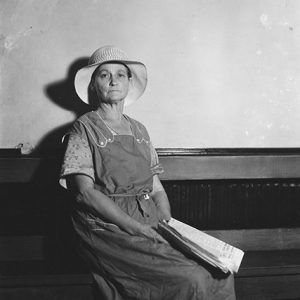calsfoundation@cals.org
Octavia Dockery (1865–1949)
Octavia Dockery was a writer, socialite, and eventual recluse who became embroiled in the “Goat Castle Murder” case in Natchez, Mississippi, in 1932. The case garnered national and international headlines when she was accused of having murdered her neighbor, Jennie Merrill. Dockery was never tried for the murder, owing to the fact that Merrill’s actual murderer was killed by Arkansas police before Dockery could be brought to trial. Her story, nevertheless, provides an excellent example of Southern Gothic come to life.
Octavia Dockery was born at Lamartine Plantation in Columbia County, Arkansas, in 1865, the daughter of Brigadier General Thomas Pleasant Dockery, who commanded the Nineteenth Arkansas Infantry Regiment during the Civil War, and Laura Octavia West Dockery. She was the great-granddaughter of Calo West, the territorial governor of Mississippi. In 1877, the Dockery family moved to New York City, where Octavia’s father worked in finance.
Octavia Dockery lived in New York City for fourteen years and attended the Comstock School for Girls. In New York, she began writing, with pieces published in the New York World newspaper. She was close to her sister, Nydia, who married Richard H. Forman (1833–1912) of Mississippi. Around 1891, Dockery, who never married, moved with her sister to Mississippi.
Dockery, who had hazel eyes, brown hair, and olive skin, was known for her beauty. Once settled in Mississippi, she “lived the life of a social butterfly,” traveling to New Orleans, Louisiana, and Vicksburg, Mississippi, to attend “balls and house parties of friends.” She kept writing, composing poetry and articles. One of her works on Louisiana plantations was published in the periodical The Blue and Gray: The Patriotic Magazine in 1894.
After the death of her sister in 1911, Dockery moved into “Glenwood,” an antebellum plantation home in Natchez that had been owned by Nydia’s husband. She lived there with Dick Dana, a friend of her sister. Dana was a popular and intelligent bon vivant who had once aspired to be a concert pianist. An injury to his hand, however, ended his music career and contributed to his mental decline.
Dockery was unhappy at Glenwood, saying she was lonely and had nothing but “ceaseless drudgery to fill my days.” She and Dana became known as recluses and eccentrics in Natchez. Dana was known as the “Wild Man,” because of his unkempt appearance and bizarre behavior. Dockery was called the “Goat Woman” because of the goats she kept on her property that had the run of the grounds and the house. Goats also intruded on the neighboring Merrill property, which was not appreciated by the owner, Jennie Merrill. On one occasion, Merrill shot one of the goats.
In 1917, Duncan Minor, a second cousin to Dockery, bought Glenwood and sought to evict Dockery and Dick Dana from the property. To avoid being evicted, Dockery had Dana declared insane. According to Mississippi law, “infants and persons judged insane” could not be deprived of their property. In the 1920s, problems persisted between Dockery and her neighbor, Jennie Merrill, who was romantically involved with Duncan Minor.
At Glenwood, Dockery led a life worthy of the gothic tales of William Faulkner or Flannery O’Connor. The house was a two-story mansion built before 1840. Inside were items that had once belonged to Jefferson Davis, Robert E. Lee, and the Reverend Charles A. Dana. By the 1930s, the house had become ramshackle and filthy, with no electricity or running water. Barnyard animals and vermin had overrun Glenwood.
On August 4, 1932, Jennie Merrill’s bullet-riddled body was found in the woods near her home. At first, Dockery was suspected. When questioned by police, she was blasé about Merrill’s death. Dana was discovered upstairs in Glenwood, washing a bloody shirt. When asked about the blood, Dana claimed it was pig’s blood (which later proved to be true). Fingerprints belonging to Dana and Dockery were discovered at the Merrill house. They were both arrested, though claimed they were innocent of murdering Merrill. The media dubbed the scandal the “Goat Castle Murder.”
The case against Dockery and Dana—who were defended by Sophie Friedman, the first woman ever to practice law in Natchez—quickly collapsed. Prosecutors called 600 potential jurors but could not find enough suitable members. On August 7, the chief of police in Pine Bluff (Jefferson County) called the Natchez sheriff to say that Pine Bluff police had recently shot and killed George Pearls, who had threatened an officer with a gun. The pistol found on Pearls was a .32 caliber handgun, the same kind used in the Merrill murder.
Forensic evidence proved that Pearls’s pistol matched the one used to kill Merrill. Also, an African-American woman named Emily Burns, who ran a boarding house in Natchez, confessed to having accompanied Pearls to Merrill’s house to demand money. Burns was convicted of being an accomplice in Merrill’s murder and sent to Parchman Farm, a Mississippi prison. In 1940, however, she was pardoned by the governor and released when it was shown that Burns had helped Pearls only under duress.
After the murder investigation, “Goat Castle” became a tourist attraction. Visitors could tour the house for fifty cents, and Dana would play piano for visitors. Dana died in 1948, and Octavia died a few months later on April 22, 1949. After their deaths, an auction was held at Glenwood with 700 people in attendance. The auctioned items sold for a total of $13,000. In 1955, Glenwood was torn down and the property turned into a subdivision.
For additional information:
Callon, Sim C., and Carolyn Vance Smith. The Goat Castle Murder: A True Natchez Story That Shocked the World. Natchez, MS: Plantation Publishing Company, 1985.
Charles East Papers. Lower Louisiana and Mississippi Valley Collection. Hill Memorial Library. Louisiana State University, Baton Rouge, Louisiana.
Cox, Karen. Goat Castle: A True Story of Murder, Race, and the Gothic South. Chapel Hill: University of North Carolina Press, 2017.
Dockery, Octavia. “The Sugar Plantations of Louisiana.” Blue and Gray 3 (February 1894): 75–79.
Sophie Friedman Papers. Sophie Smith Collection. Smith College, Northampton, Massachusetts.
Colin Edward Woodward
Lee Family Digital Archive, Stratford Hall
 Early Twentieth Century, 1901 through 1940
Early Twentieth Century, 1901 through 1940 Literature and Authors
Literature and Authors Women
Women Octavia Dockery
Octavia Dockery  Goat Castle
Goat Castle 



Comments
No comments on this entry yet.